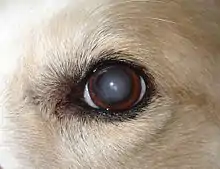Nuclear sclerosis
Nuclear sclerosis is an age-related change in the density of the crystalline lens nucleus that occurs in all older animals.[1] It is caused by compression of older lens fibers in the nucleus by new fiber formation. The denser construction of the nucleus causes it to scatter light. Although nuclear sclerosis may describe a type of early cataract in human medicine,[2] in veterinary medicine the term is also known as lenticular sclerosis and describes a bluish-grey haziness at the nucleus that usually does not affect vision, except for unusually dense cases. Immature senile cataract has to be differentiated with nuclear sclerosis while making its diagnosis.[3]

Veterinary Medicine
In veterinary practice, nuclear sclerosis is a consistent finding in dogs greater than six years old.[4] Nuclear sclerosis appears as a bilateral bluish-grey haziness at the nucleus, or center of the lens, caused by an increase in the refractive index of that part of the lens due to its increased density. It is often confused with cataracts. The condition is differentiated from a cataract by its appearance and by shining a penlight into the eye. With nuclear sclerosis, a reflection from the tapetum will be seen, while a cataract will block reflection.[5] There is no treatment for this condition currently.
References
- "Cataract Surgery – FAQs: What is nuclear sclerosis?" Archived 2007-03-13 at the Wayback Machine Iowa State University, College of Veterinary Medicine, Veterinary Teaching Hospital, Ophthalmology Department. Accessed November 18, 2006.
- Cassin, B. and Solomon, S. Dictionary of Eye Terminology. Gainesville, Florida: Triad Publishing Company, 1990.
- Sapienza, John S. (2002). "Cataracts". Proceedings of the 27th World Congress of the World Small Animal Veterinary Association. Retrieved 2007-03-13.
- Gelatt, Kirk N. (ed.) (1999). Veterinary Ophthalmology (3rd ed.). Lippincott, Williams & Wilkins. ISBN 0-683-30076-8.
{{cite book}}:|author=has generic name (help) - Petersen-Jones, Simon M. (2003). "Conditions of the Lens". Proceedings of the 28th World Congress of the World Small Animal Veterinary Association. Retrieved 2007-03-13.